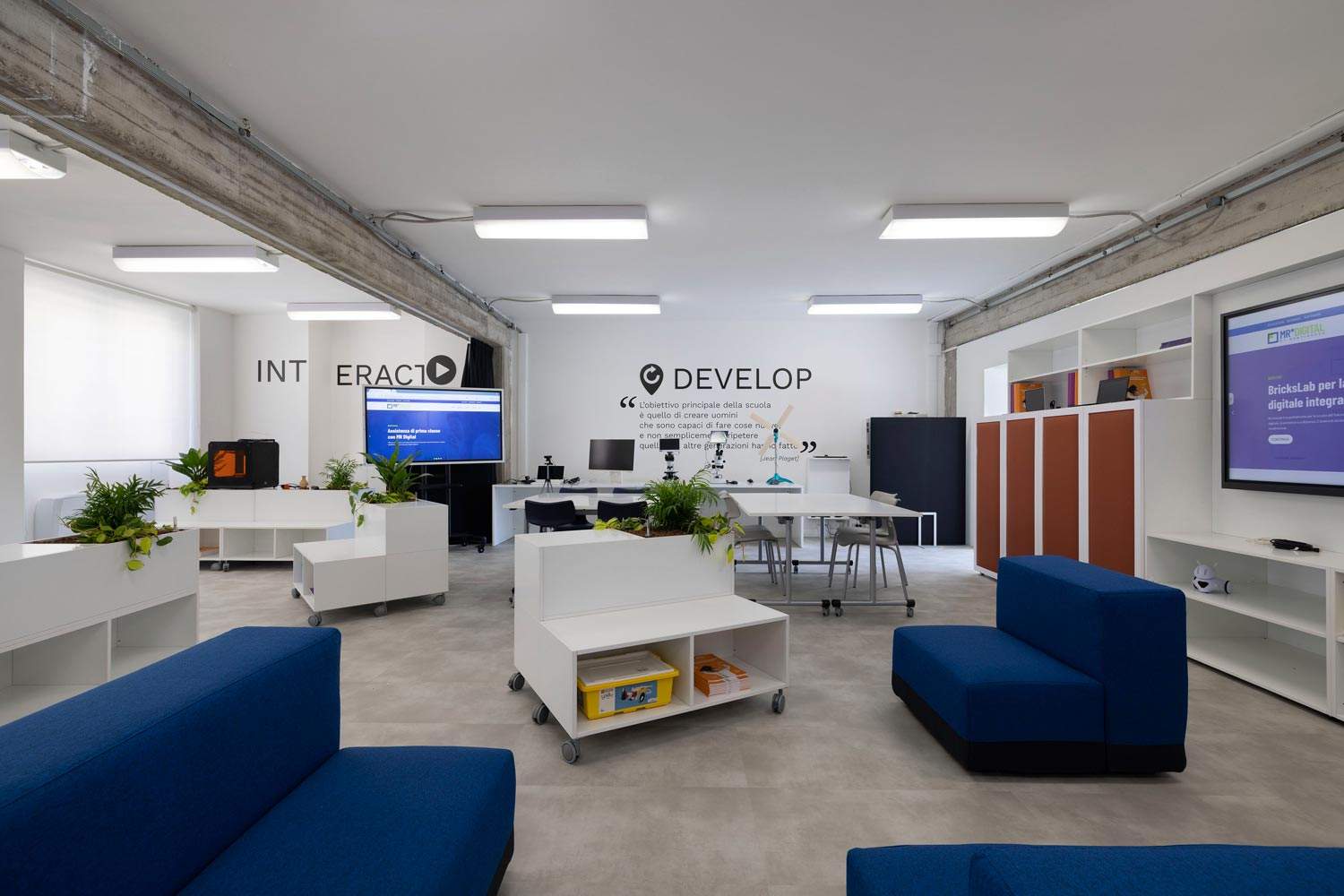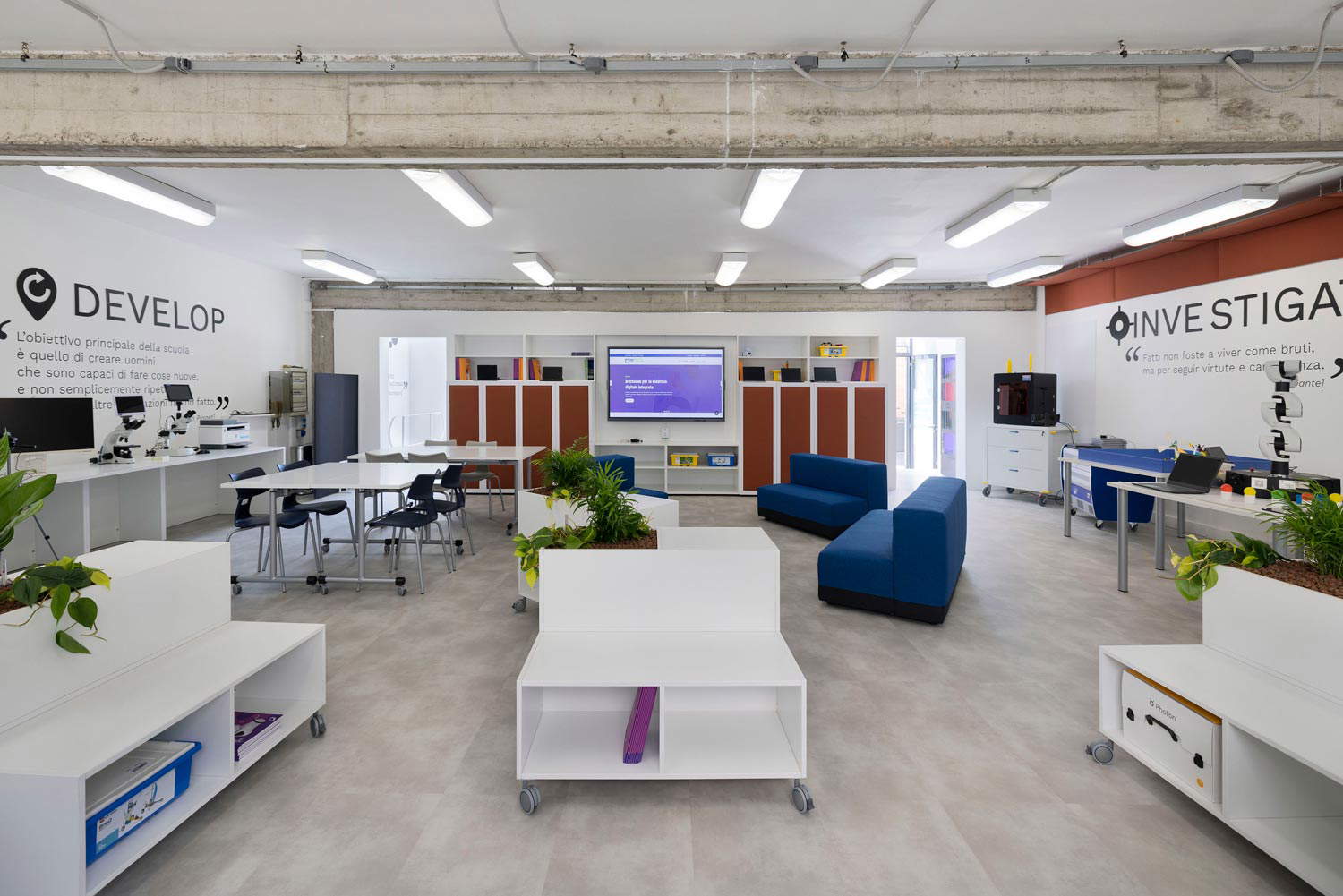What will the school of the future look like? According to MR Digital and Stefano Boeri Interiors it will have Learning Environments 4.0 that will revolutionize classrooms as we have known them so far. And to give the public a glimpse of how our children will go to school, here opens in Milan the space Learning Environments 4. 0 for the school of the future, an installation created with cutting-edge technologies that expand the possibilities of learning and teaching beyond the confines of the physical classroom and is created by MR Digital (an Italian digital transformation company among the most important specialists in the education sector), inspired by European Schoolnet’s Future Classroom Lab, which houses Learning Environments 4.0, a learning space model designed by Stefano Boeri Interiors that focuses on the new needs of teachers and students. It can be visited starting today, for the opening of Milan Design Week, at Studio 31 - Opificio 31 on Via Tortona 31 in Milan, and will host workshops and events for schools and citizenship until July.
The idea stems from an observation: in the historical period we are living, characterized by uncertainty and rapid changes that involve every aspect of our society, even schools are called to innovate and integrate new technologies into teaching. A need highlighted by the Ministry of Education, which with the PNRR, under the investment line Plan School 4.0, intended to invest 2.1 billion euros for the transformation of traditional classrooms into innovative learning environments and in the creation of laboratories for the digital professions of the future. This is a call that starts with the overhaul of spaces to promote a broader evolution in favor of sustainability, inclusiveness, flexibility and integration between physical space and new technologies.
MR Digital has therefore worked on a project that responds to these calls. Learning Environments 4.0 for the School of the Future intends to focus on the needs and well-being of those who live in schools every day: students and teachers. The traditional classroom becomes a flexible and multifunctional environment, with different possible configurations depending on the individual need or lesson, healthy and safe. Special attention is paid to all those elements that promote concentration, but also to the adoption of sustainable materials and inclusion as much as possible. Technology, thanks to the collaboration with some of the most important brands in the industry, becomes a tool that supports and complements traditional teaching, fostering experiential learning methods that facilitate collaboration and making it easier to respond to the needs of each student and the world of work.
The space will also be a meeting point, both during Milan Design Week and in the following months, for the school community and citizenship to discuss the changes taking place in the world of education, how to create learning environments that meet ministerial guidelines and take into account the specific needs of the individual institution, and how new technologies can support teaching.
The space is divided into five main areas, whose characteristics echo the learning zones identified by the Future Classroom Lab. At the center is the Present zone: an agora with sound-absorbing sofas and interactive monitors where students have the opportunity to share what they create. A process that goes beyond just presenting and includes comparing and getting feedback.
On the left, the Investigate and Exchange area houses tables for coding and robotics and hydroponic greenhouses that encourage collaboration among students, a key aspect of learning that allows them to reinforce a sense of individual and group responsibility and the ability to work and make decisions as a team. The area also stimulates proactivity and manual dexterity, inviting pupils to investigate and make discoveries on their own. On the right, the Develop area, with tables and chairs that can be used or stored in a cabinet as needed and a cart with interactive monitors, encourages informal learning, reflection, and individual study at one’s own pace and interests. Finally, in the Interact area, teachers guide pupils through the various steps of learning. This does not limit students to being passive listeners, since, thanks to the integration of new technologies, each of them can actively contribute.
Finally, on the lower floor, it is possible to delve into the Create area, where pupils can practice what they have learned by creating their own digital content (audio and video) and also includes a “photo booth” (photo booth) and a podcast recording station. An immersive classroom and virtual and augmented reality viewers can also be found. To support the diverse learning needs that emerge, the space is designed with attention to the use of flexible and modular elements, movable walls and furniture that can be moved easily.
“Schools,” says Andrea Russo, CEO of MR Digital, “are facing a moment of change that, although it may be frightening, is a great opportunity. Thanks to the funds made available by PNRR, it is possible to renovate environments to create a didactics that meets the needs of pupils who live in an increasingly digital world and want to access a potentially infinite number of resources. A didactics that must know how to make the best of these resources and new technologies and support young people in their learning journey, making sure they know how to use digital safely. We are delighted that Stefano Boeri Interiors accepted our invitation to collaborate and create this space that we are making available to the school community today.”
Partners who collaborated in the creation or furnishing of Learning Environments 4.0 for the School of the Future are Vastarredo, Caimi, GR Group, Corriere della Sera Google for Education, Microsoft, Comau, Epson, Esprinet, Eugeni Lab, HP, Kentstrapper, LEGO® Education, Lenovo, ML Systems, Napisan, Photon, Samsung Electronics Italia, and Tomato+.
Free workshops and events aimed at citizens and the school community are planned during Milan Design Week. You can learn about the calendar at this link. Additional events and workshops will also be held in the coming months.


 |
| This is what the classrooms of the future will look like, according to MR Digital and Stefano Boeri |
Warning: the translation into English of the original Italian article was created using automatic tools. We undertake to review all articles, but we do not guarantee the total absence of inaccuracies in the translation due to the program. You can find the original by clicking on the ITA button. If you find any mistake,please contact us.